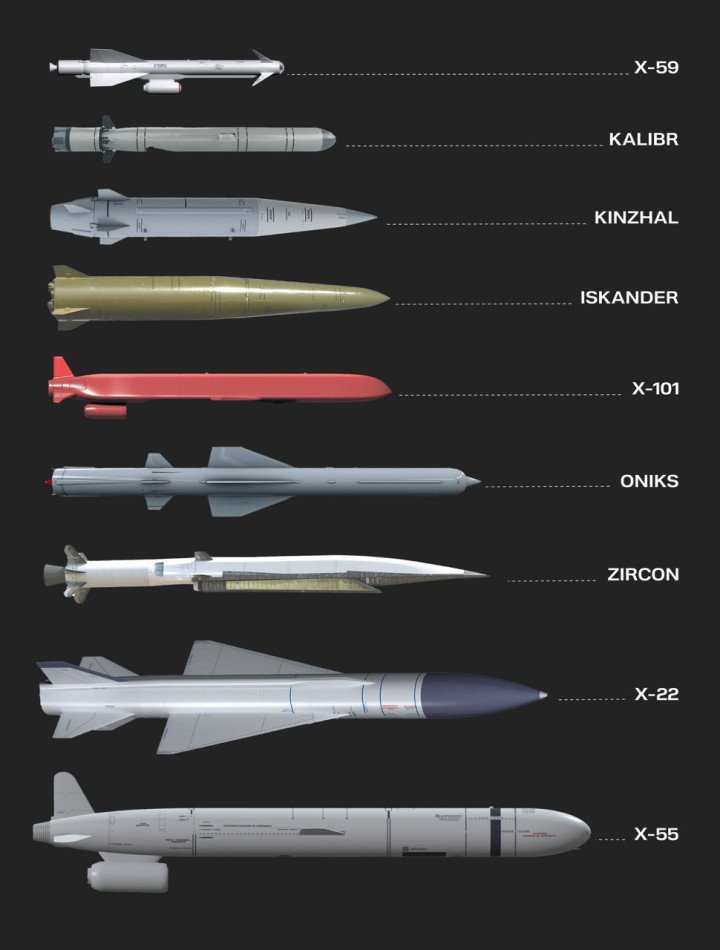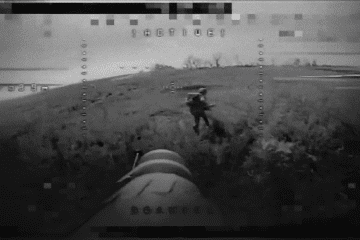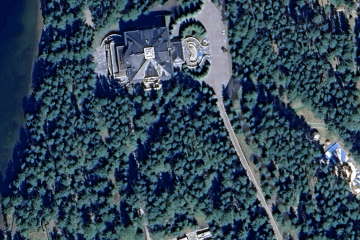- Category
- War in Ukraine
All the Missiles Russia Uses Against Ukraine, Underscoring Urgency of Air Defense

Iskander, Kalibr, Zircon: Russia employs a dozen different types of missiles to bombard Ukrainian territory, ranging from modern weaponry to remnants from Soviet times. Ukraine needs support in shooting them down.
In 2024, Russia began to target Ukraine with its latest weapon—the hypersonic Zircon missile, which takes about 3 minutes to reach Kyiv from Crimea. Boasting long-range flight capabilities and formidable power, Russia claims that it is its most advanced development to date. Nonetheless, Ukraine has consistently intercepted Zircons, thanks to allied air defense systems and the capabilities of the Ukrainian Armed Forces. But these are not the only types of missiles Russia uses to bomb Ukraine. There are dozens of others, like the Oniks missiles—meant to destroy ships but used by Russia to destroy land targets. On July 8th, Russia used an X-101 to attack “Okhmatdyt” children’s hospital in Kyiv.
To date, over 5000 missiles have been launched by Russia since the onset of the full-scale invasion. However, a large portion of them have been successfully intercepted by Ukraine.
We look at all the types of missiles the Russian army is using against Ukraine to illustrate why Ukraine urgently needs more air defense systems to protect its people.

Kalibr: Sea-launched cruise missiles, sent from submarines and military ships.
Missile range - up to 2600 km.
Speed - 970 km/h.
Warhead - 250-400 kg.
They are launched from the Black Sea, and sometimes from the Caspian Sea.
Kinzhal: Ballistic missiles, launched from aircraft.
Missile range - up to 3000 km.
Speed - around 12,000 km/h.
Warhead - 500 kg.
Kinzhal missiles are also capable of carrying a nuclear payload.
Iskander: Ballistic missile, ground-launched.
Missile range - up to 500 km.
Speed - around 8800 km/h.
Warhead - 480 kg.
Iskander missiles can also carry a nuclear payload.
Oniks: Anti-ship missile, ground-launched.
Missile range - up to 800 km.
Speed - 2700 km/h.
Warhead - 200-300 kg.
The Russian army also targets ground targets in Ukraine with Oniks missiles.
Zircon: Hypersonic winged anti-ship missile, launched from submarines and military ships.
Missile range - up to 1000 km.
Speed - 11,000 km/h.
Warhead - up to 400 kg.
It’s considered Russia’s newest and most secretive weapon. It was first used during Russia's full-scale invasion of Ukraine, during the bombardments in 2023 and 2024. Examination of missile fragments indicates that some of the claimed characteristics do not correspond with reality. In addition, the Russians have claimed the missile was impossible to intercept, but Ukraine managed to do so with Patriot Air Defense Systems.
X-22: Winged anti-ship missile, launched from aviation, Tu-22.
Missile range - up to 600 km.
Speed - 4000 km/h.
Warhead - 960 kg.
This is the oldest type of Russian anti-ship missile. The missile was designed to destroy enemy aircraft carriers, but in the current war, it is used against ground targets in Ukraine. The missile has very low accuracy, with errors potentially spanning kilometers. Thus its use against ground targets invariably results in significant casualties.
X-55: Aviation missile, launched from aviation.
Missile range - up to 2500 km.
Speed - 890 km/h.
Warhead - 450 kg.
It's designed to destroy strategic ground targets, but it’s not a highly accurate weapon.
X-59: Medium-range aviation missile, launched from aviation.
Missile range - up to 300 km.
Speed - 1000 km/h.
Warhead - 310 kg.
X-101: Winged missile, launched from aviation.
Missile range - up to 5000 km.
Speed - 700 km/h.
Warhead - 400 kg.
Since the start of the full-scale invasion, hundreds of such missiles have been launched at Ukraine.
S-300 / S-400: These are missile systems designed to intercept aerial targets—such as airplanes.
Russia has a large stockpile of missiles for these systems and therefore uses them to strike against ground targets in Ukraine. Missiles from the S-300 / S-400 systems can travel distances ranging from 10 to 240 kilometers. They are therefore only used to strike cities close to the front lines, like Kharkiv.
How much of them does Russia have?
The vast majority of missiles used by Russia to strike Ukraine were developed during the Soviet era and are often not very precise. But there are likely large stockpiles of such missiles—stored in large quantities in warehouses around Russia.
There is, of course, newer weaponry in Russia too—like the Kinzhal, Iskander, or X-101 missiles. But their stocks are relatively small, and it is said that only about 10 of them can be produced per year. It is important to note that the production of these missiles in Russia relies heavily on foreign components, with hundreds of different components in each missile.
Furthermore, the production of such missiles also requires Western high-precision machines, the supply of which is often not subject to sanctions. Therefore, to prevent Russia from manufacturing such weapons or to reduce its scale, additional sanctions are necessary, as well as monitoring their implementation.
Another important aspect is air defense. Despite Russia's claims that some of its missiles cannot be intercepted—this is not the case. Ukrainian defenders have successfully intercepted all types of missiles directed at Ukrainian territory, thanks to Western air defense systems: IRIS/T, NASAMS, Patriot, and others.
All of these weapons have proven to be excellent in terms of airspace defense, demonstrating their effectiveness in real combat situations. Moreover, the war in Ukraine has shown that with a sufficient number of munitions and a good quantity of air defense assets, practically any mass attack by the enemy can be repelled. For example, on December 29, 2023, Russia launched 158 attacks on Ukraine, including over a hundred missiles and dozens of Shahed drones. Ukraine managed to intercept 27 Shahed drones and 89 missiles of various classes. The only problem was that there were not enough assets to cover the vast territory of Ukraine.
Therefore, Ukrainian President Volodymyr Zelensky has been requesting from the onset of the full-scale invasion that partners provide more Patriot Air Defense Systems for Ukraine as well as munitions for them. With a sufficient quantity of both, protecting the skies of Ukraine is achievable.
-29a1a43aba23f9bb779a1ac8b98d2121.jpeg)

-f88628fa403b11af0b72ec7b062ce954.jpeg)
-b63fc610dd4af1b737643522d6baf184.jpg)



-24deccd511006ba79cfc4d798c6c2ef5.jpeg)